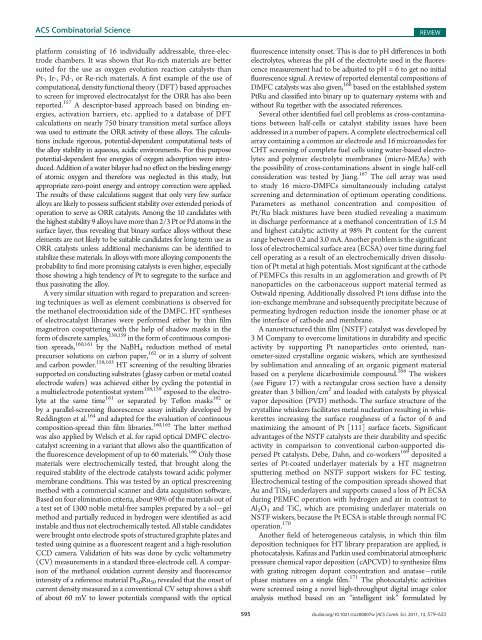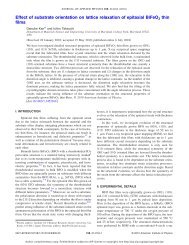Combinatorial and High-Throughput Screening of Materials ...
Combinatorial and High-Throughput Screening of Materials ...
Combinatorial and High-Throughput Screening of Materials ...
Create successful ePaper yourself
Turn your PDF publications into a flip-book with our unique Google optimized e-Paper software.
ACS <strong>Combinatorial</strong> Science<br />
platform consisting <strong>of</strong> 16 individually addressable, three-electrode<br />
chambers. It was shown that Ru-rich materials are better<br />
suited for the use as oxygen evolution reaction catalysts than<br />
Pt-, Ir-, Pd-, or Re-rich materials. A first example <strong>of</strong> the use <strong>of</strong><br />
computational, density functional theory (DFT) based approaches<br />
to screen for improved electrocatalyst for the ORR has also been<br />
reported. 157 A descriptor-based approach based on binding energies,<br />
activation barriers, etc. applied to a database <strong>of</strong> DFT<br />
calculations on nearly 750 binary transition metal surface alloys<br />
was used to estimate the ORR activity <strong>of</strong> these alloys. The calculations<br />
include rigorous, potential-dependent computational tests <strong>of</strong><br />
the alloy stability in aqueous, acidic environments. For this purpose<br />
potential-dependent free energies <strong>of</strong> oxygen adsorption were introduced.<br />
Addition <strong>of</strong> a water bilayer had no effect on the binding energy<br />
<strong>of</strong> atomic oxygen <strong>and</strong> therefore was neglected in this study, but<br />
appropriate zero-point energy <strong>and</strong> entropy correction were applied.<br />
The results <strong>of</strong> these calculations suggest that only very few surface<br />
alloys are likely to possess sufficient stability over extended periods <strong>of</strong><br />
operation to serve as ORR catalysts. Among the 10 c<strong>and</strong>idates with<br />
the highest stability 9 alloys have more than 2/3 Pt or Pd atoms in the<br />
surface layer, thus revealing that binary surface alloys without these<br />
elements are not likely to be suitable c<strong>and</strong>idates for long-term use as<br />
ORR catalysts unless additional mechanisms can be identified to<br />
stabilize these materials. In alloys with more alloying components the<br />
probability to find more promising catalysts is even higher, especially<br />
those showing a high tendency <strong>of</strong> Pt to segregate to the surface <strong>and</strong><br />
thus passivating the alloy.<br />
A very similar situation with regard to preparation <strong>and</strong> screening<br />
techniques as well as element combinations is observed for<br />
the methanol electrooxidation side <strong>of</strong> the DMFC. HT syntheses<br />
<strong>of</strong> electrocatalyst libraries were performed either by thin film<br />
magnetron cosputtering with the help <strong>of</strong> shadow masks in the<br />
form <strong>of</strong> discrete samples, 158,159 in the form <strong>of</strong> continuous composition<br />
spreads, 160,161 by the NaBH 4 reduction method <strong>of</strong> metal<br />
precursor solutions on carbon paper, 162 or in a slurry <strong>of</strong> solvent<br />
<strong>and</strong> carbon powder. 158,163 HT screening <strong>of</strong> the resulting libraries<br />
supported on conducting substrates (glassy carbon or metal coated<br />
electrode wafers) was achieved either by cycling the potential in<br />
a multielectrode potentiostat system 158,159 exposed to the electrolyte<br />
at the same time 161 or separated by Teflon masks 162 or<br />
by a parallel-screening fluorescence assay initially developed by<br />
Reddington et al. 164 <strong>and</strong> adapted for the evaluation <strong>of</strong> continuous<br />
composition-spread thin film libraries. 160,165 The latter method<br />
was also applied by Welsch et al. for rapid optical DMFC electrocatalyst<br />
screening in a variant that allows also the quantification <strong>of</strong><br />
the fluorescence development <strong>of</strong> up to 60 materials. 166 Only those<br />
materials were electrochemically tested, that brought along the<br />
required stability <strong>of</strong> the electrode catalysts toward acidic polymer<br />
membrane conditions. This was tested by an optical prescreening<br />
method with a commercial scanner <strong>and</strong> data acquisition s<strong>of</strong>tware.<br />
Based on four elimination criteria, about 90% <strong>of</strong> the materials out <strong>of</strong><br />
a test set <strong>of</strong> 1300 noble metal-free samples prepared by a sol gel<br />
method <strong>and</strong> partially reduced in hydrogen were identified as acid<br />
instable <strong>and</strong> thus not electrochemically tested. All stable c<strong>and</strong>idates<br />
were brought onto electrode spots <strong>of</strong> structured graphite plates <strong>and</strong><br />
tested using quinine as a fluorescent reagent <strong>and</strong> a high-resolution<br />
CCD camera. Validation <strong>of</strong> hits was done by cyclic voltammetry<br />
(CV) measurements in a st<strong>and</strong>ard three-electrode cell. A comparison<br />
<strong>of</strong> the methanol oxidation current density <strong>and</strong> fluorescence<br />
intensity <strong>of</strong> a reference material Pt 50 Ru 50 revealed that the onset <strong>of</strong><br />
current density measured in a conventional CV setup shows a shift<br />
<strong>of</strong> about 60 mV to lower potentials compared with the optical<br />
REVIEW<br />
fluorescence intensity onset. This is due to pH differences in both<br />
electrolytes, whereas the pH <strong>of</strong> the electrolyte used in the fluorescencemeasurementhadtobeadjustedtopH=6togetnoinitial<br />
fluorescence signal. A review <strong>of</strong> reported elemental compositions <strong>of</strong><br />
DMFC catalysts was also given, 166 based on the established system<br />
PtRu <strong>and</strong> classified into binary up to quaternary systems with <strong>and</strong><br />
without Ru together with the associated references.<br />
Several other identified fuel cell problems as cross-contaminations<br />
between half-cells or catalyst stability issues have been<br />
addressed in a number <strong>of</strong> papers. A complete electrochemical cell<br />
array containing a common air electrode <strong>and</strong> 16 microanodes for<br />
CHT screening <strong>of</strong> complete fuel cells using water-based electrolytes<br />
<strong>and</strong> polymer electrolyte membranes (micro-MEAs) with<br />
the possibility <strong>of</strong> cross-contaminations absent in single half-cell<br />
consideration was tested by Jiang. 167 The cell array was used<br />
to study 16 micro-DMFCs simultaneously including catalyst<br />
screening <strong>and</strong> determination <strong>of</strong> optimum operating conditions.<br />
Parameters as methanol concentration <strong>and</strong> composition <strong>of</strong><br />
Pt/Ru black mixtures have been studied revealing a maximum<br />
in discharge performance at a methanol concentration <strong>of</strong> 1.5 M<br />
<strong>and</strong> highest catalytic activity at 98% Pt content for the current<br />
range between 0.2 <strong>and</strong> 3.0 mA. Another problem is the significant<br />
loss <strong>of</strong> electrochemical surface area (ECSA) over time during fuel<br />
cell operating as a result <strong>of</strong> an electrochemically driven dissolution<br />
<strong>of</strong> Pt metal at high potentials. Most significant at the cathode<br />
<strong>of</strong> PEMFCs this results in an agglomeration <strong>and</strong> growth <strong>of</strong> Pt<br />
nanoparticles on the carbonaceous support material termed as<br />
Ostwald ripening. Additionally dissolved Pt ions diffuse into the<br />
ion-exchange membrane <strong>and</strong> subsequently precipitate because <strong>of</strong><br />
permeating hydrogen reduction inside the ionomer phase or at<br />
the interface <strong>of</strong> cathode <strong>and</strong> membrane.<br />
A nanostructured thin film (NSTF) catalyst was developed by<br />
3 M Company to overcome limitations in durability <strong>and</strong> specific<br />
activity by supporting Pt nanoparticles onto oriented, nanometer-sized<br />
crystalline organic wiskers, which are synthesized<br />
by sublimation <strong>and</strong> annealing <strong>of</strong> an organic pigment material<br />
based on a perylene dicarboximide compound. 168 The wiskers<br />
(see Figure 17) with a rectangular cross section have a density<br />
greater than 3 billion/cm 2 <strong>and</strong> loaded with catalysts by physical<br />
vapor deposition (PVD) methods. The surface structure <strong>of</strong> the<br />
crystalline whiskers facilitates metal nucleation resulting in whiskerettes<br />
increasing the surface roughness <strong>of</strong> a factor <strong>of</strong> 6 <strong>and</strong><br />
maximizing the amount <strong>of</strong> Pt [111] surface facets. Significant<br />
advantages <strong>of</strong> the NSTF catalysts are their durability <strong>and</strong> specific<br />
activity in comparison to conventional carbon-supported dispersed<br />
Pt catalysts. Debe, Dahn, <strong>and</strong> co-workers 169 deposited a<br />
series <strong>of</strong> Pt-coated underlayer materials by a HT magnetron<br />
sputtering method on NSTF support wiskers for FC testing.<br />
Electrochemical testing <strong>of</strong> the composition spreads showed that<br />
Au <strong>and</strong> TiSi 2 underlayers <strong>and</strong> supports caused a loss <strong>of</strong> Pt ECSA<br />
during PEMFC operation with hydrogen <strong>and</strong> air in contrast to<br />
Al 2 O 3 <strong>and</strong> TiC, which are promising underlayer materials on<br />
NSTF wiskers, because the Pt ECSA is stable through normal FC<br />
operation. 170<br />
Another field <strong>of</strong> heterogeneous catalysis, in which thin film<br />
deposition techniques for HT library preparation are applied, is<br />
photocatalysis. Kafizas <strong>and</strong> Parkin used combinatorial atmospheric<br />
pressure chemical vapor deposition (cAPCVD) to synthesize films<br />
with grating nitrogen dopant concentration <strong>and</strong> anatase rutile<br />
phase mixtures on a single film. 171 The photocatalytic activities<br />
were screened using a novel high-throughput digital image color<br />
analysis method based on an “intelligent ink” formulated by<br />
595 dx.doi.org/10.1021/co200007w |ACS Comb. Sci. 2011, 13, 579–633












